
There are four or six of them in camouflage overalls. They have waited perhaps for hours, in a van parked on a street corner, to see a girl with her veil out of place. They get out of the vehicle like rabid dogs, armed with sticks, and start beating her savagely, sparing no blows to those who try to defend the poor woman. They are mastiffs unleashed by a hated and incapacitated regime, which only survives through brutality. They are the policemen of Iranian morality: beasts paid to kill and humiliate the women of their country – and they are all too effective.
The population recognises the trucks and tries to pay attention when it sees them. But at 20, there is always someone who attempts the stunt, or is distracted, or is unable to assess what might happen. It’s a moment. You were in the company of friends and girlfriends and talking about the billions of wonderful things that are a theme at that age, and a second later you are on the ground, covered in your own blood, and you are beaten to death. Because you are a woman – and the regime hates women most of all, especially if they are young.
Being a woman, in much of the world, is an uphill race. Serenity is forbidden. Mistreated and humiliated for centuries, handmaiden or slave, subservient to cowards who only make their strength in packs or uniforms, they are denied peace of mind, and even to go unnoticed. Violence against them is masked with religious taboos, and this is not only in countries where fundamentalism is in power – but in those countries, of course, the persecution of women happens in the open, without being hidden.
Where the inability to run a nation is masked by religious extremism, unfortunately, the situation is worse than elsewhere. The law is replaced by the rules of the shari’a, which is a set of indications taken in small part from the Koran, and above all from later texts and commentaries (not all of which are recognised as sacred by all the many Muslim factions), and which divides human actions between lawful and, at the bottom of a scale of prohibitions, intolerable.
A law that every anti-democratic regime moulds to its own liking, and which no longer has anything to do with the recommendations made by Muhammad. Since this law also prohibits entering into insurance contracts and making money by borrowing, the economic capacity of the states that apply it is limited1. These are the countries (such as Afghanistan, Iran, Mauritania, Yemen and Sudan) where theocratic regimes are most intransigent and most violent against women – not to mention areas where terrorist groups, such as Boko Haram in Nigeria, make hatred of women a tool of blackmail against the states in which they operate2.
Among the most notorious regulations are the compulsory wearing of the veil (hijab) and loose clothing to conceal hair and shape3. The compulsory hijab is one of the three remaining ideological pillars of the regime in Iran, along with the slogans ‘Death to America’ and ‘Death to Israel’4. One of the richest countries on earth has been in the midst of a deep economic crisis for almost half a century now – and the theocracy has become unbearable for the vast majority of the population. The moral police, known as Gasht-e Ershad5 , is the armed arm of the regime – the most efficient way to force everyone into fear. This group, on 13 September 2022, arrested and beat Mahsa Amini – a young Kurdish woman, who died after three days of unspeakable suffering in hospital6.
Mahsa’s death
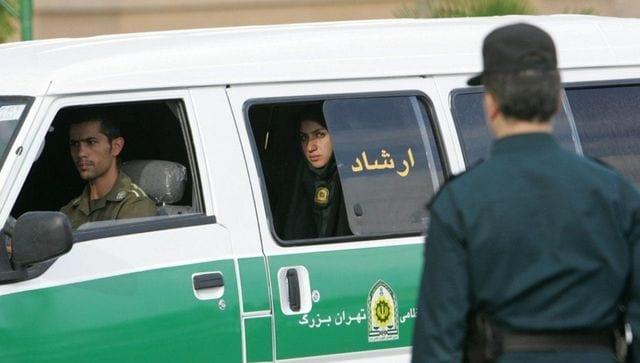
Gasht-e Ershad, Iran’s moral police enforce the country’s conservative dress code7
Mahsa Amini, 22 years old8, together with her brother Kiarash9, is travelling between the capital and her parents’ home in north-west Kurdistan10. At the entrance to a metro station she is arrested by the morality police because she is not wearing the hijab properly11 . Her brother tries to explain that they do not know Tehran, and begs that his sister not be arrested12. The thugs tell Kiarash that she will be released after attending a ‘training course‘13.
The brother insists, and the police officers spray him in the face with pepper spray14. They force Mahsa into the van where on the way, according to eyewitnesses, she is violently beaten by the authorities. After losing consciousness in the detention centre15 on Vozara Avenue, she is admitted to Kasra hospital in ‘Code 99’, i.e. close to death16. Amini died, in fact, after three days in a coma17.
Her family and protesters claim that she died of injuries sustained during the police beating. The Iranian authorities claim that an initial coroner’s inquest shows that she died of heart failure or a stroke18. Very unlikely and implausible diagnoses in a woman of only 22 years, so much so that her family vehemently rejects the police statement, claiming that Mahsa was in good health at the time of her arrest19. Images of her, taken at the hospital, show bruising around both eyes and on her ears – something that occurs after severe trauma. There are other women, arrested together with Mahsa, who were later released: their phones are checked to ensure that no one had taken photos or videos of the incident20.
The protests

Tehran, 24 September 2022: Thousands of Iranians on the streets to protest against the murder of Mehsa Amini21
Her cousin, Erfan Mortezaei tells CBS News22 how Mahsa became the ‘voice of the anger of the Iranian people’. He, a political activist and Peshmerga fighter23 living in exile in Iraq, says it took 30 minutes before the ambulance reached her and an hour and a half before she arrived at the hospital. A hospital report confirms that death was caused by a blow to the head. Mortezaei added that there was pressure on the family to prevent him from speaking out. Finally, he emphasised that contrary to the media reports close to the ayatollahs, Amini was not interested in politics24.
In response to this murder, furious protests in favour of women’s rights broke out and quickly spread to dozens of Iranian cities. Women took to the streets burning headscarves and cutting their hair in anger and defiance as they confronted police, militias and strict hijab laws, in what has become the biggest challenge to the regime in years25. Cutting one’s hair is a symbol of mourning. In some villages in Iran, there are trees where women who lose their husbands in their youth hang their braided and cut hair26.
The army is ready to crush dissent, and has no qualms about confronting ‘the enemies’ hidden behind the riots27. Iranian women become symbols of the uprising: Hadis Najafi, 20, filmed in a video without a veil, ties up her dyed blond hair before joining the protests for Mahsa Amini. She is killed with six bullets to the chest, neck and heart, in front of everyone, while shouting ‘Woman, life, freedom’28. Nika Shakarami, 17, who disappeared a few days ago, was found dead in the morgue by her family. Her face tells of the beating she received and which killed her29.
The Iranian judiciary ordered to take a hard line against the protesters, claiming they were led by foreign agents and fomented by anti-Iranian social media30. The IRGC, the Islamic Revolutionary Guard Corps, orders that the protesters should be ‘taught a lesson’31. Justice Minister Gholam Hossein Mohseni Ejei32 calls for ‘immediate and deterrent action’ by the country’s judicial authorities against ‘major troublemakers and professional rioters’. Mohseni Ejei calls for punishing people who ‘damage public property, disobey the police and are linked to foreign intelligence services’33.
State TV claims that the protests are organised with the aim of creating unrest, and the death of Mahsa Amini is being used as an excuse by Kurdish separatists. Catalysed by the violence against this innocent young woman, the dissent in Iran reveals the deep anger of a nation that resents decades of female oppression at the hands of a theocratic regime34. The government response is not slow in coming. During his speech at the 77th UN General Assembly in New York, Iranian President Seyyed Ebrahim Raisi35 , a friend of Vladimir Putin36 , while negotiating the nuclear deal, denounces Western bias, deflecting criticism from world leaders37. He adds that he has ordered an investigation into the case of Mahsa Amini38 , but laments the use of double standards: “Every day, in several countries, including the United States, we see men and women dying in clashes with the police, but there is no awareness of the causes of this violence”39.
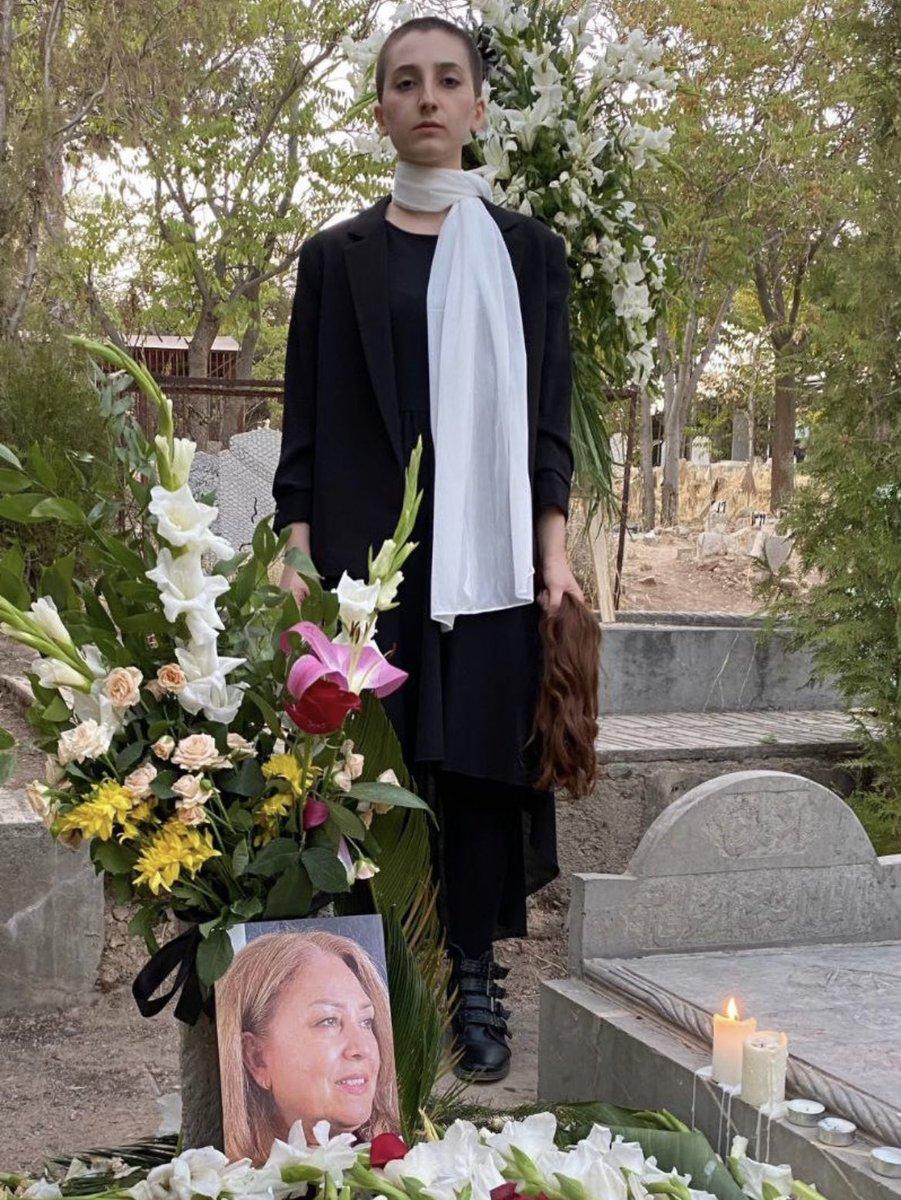
Minoo Majidi’s daughter in front of her mother’s grave40
He does not talk about the current state of his country, where the Internet, Instagram and Whatsapp are blocked41 by the authorities, women burn their hijabs in the streets and dozens of people die as protests against the regime intensify42. During a visit to New York Raisi asks CNN journalist Christiane Amanpour43 to wear a headscarf for an interview. Amanpour points out that no previous president had requested this. The interview would be Raisi’s first during his visit to the UN. It would be: why does the president not show up for the meeting44.
Under his government, the morality police expand patrols on the streets. Women are slapped, hit with batons and thrown into police vans for not wearing the hijab ‘properly’, says a UN human rights official45. Many have published footage of violent police attacks on people demonstrating on the streets of Iranian cities46. Videos of public outrage and widespread dissent are making the rounds on social networks, while eyewitnesses and human rights groups claim that the authorities have severely repressed protesters with live ammunition, pellet guns and tear gas47.
Most of the unrest is concentrated in the Kurdish-populated north-west of Iran, but extends to the capital and at least 50 cities48. A feeling of outrage rises from the UN and ordinary people49. The United States announced the easing of export restrictions to improve Iranians’ access to the Internet: “This is a concrete step to provide meaningful support to Iranians demanding respect for their fundamental rights,” said US Secretary of State, Antony Blinken50. Italy too condemns Mahsa’s murder. These days, in many cities, the ‘Freedom Rally for Iran’ is being held as a sign of solidarity with Iranian youth.
Processions and sit-ins are organised from Rome to Tokyo. Many protest actions: the cutting of locks of hair, slogans against the Iranian government and in favour of women’s freedom51. Olympic 100 metre champion Marcel Jacobs52 sided ‘with all women and men protesting for their freedom’53. Harry Potter author JK Rowling54 praises Iranian women for the courage of their protests and shares a clip showing a policeman beating women with a baton55. In the last few hours, another photo has been doing the rounds on the web: that of the daughter of Minoo Majidi, a woman who took to the streets in protest and was barbarically beaten by the police. The daughter cut her hair and removed her veil, precisely to show that her desire for freedom, and respect for her mother’s sacrifice, are greater than fear56.
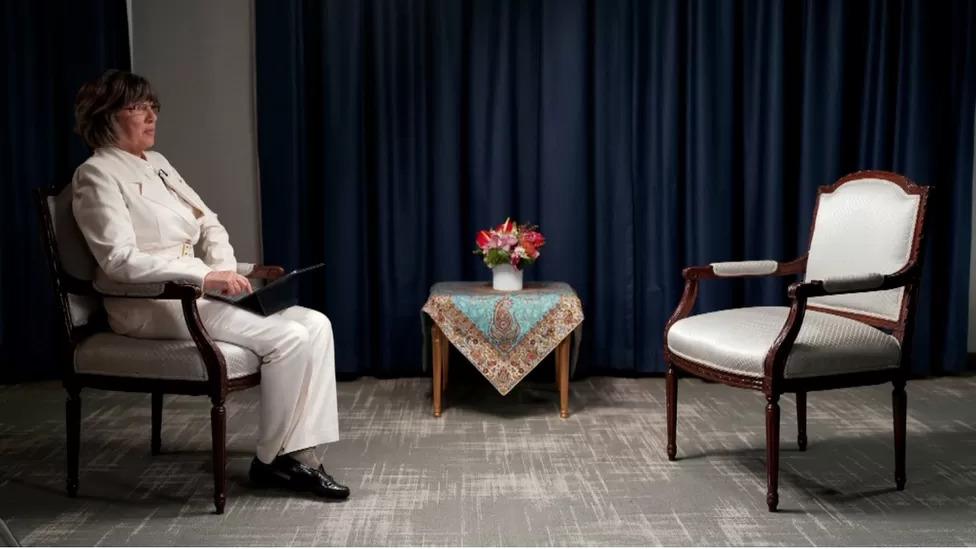
Journalist Christiane Amanpour waits in vain for Iranian President Raisi57
The Iranian authorities want to prevent local reporters from reporting on the protests58. Ravina Shamdasani59 , spokesperson for the UN High Commissioner for Human Rights, says that hundreds of people were arrested, including human rights defenders, lawyers, civil society activists and at least 18 journalists. Among them also the daughter of former Iranian President Ali Akbar Hashemi Rafsanjani60, Fazeh Hashemi. The intransigent Tasnim news agency61, affiliated with the Islamic Revolutionary Guards Corps (IRGC)62, reported that Hashemi was arrested by security forces in eastern Tehran for ‘inciting a riot63.
Hashemi, 69, is a former journalist and human rights activist. Her father was president from 1989 to 199764. During last year’s presidential vote, which brought the intransigent Ebrahim Raisi to power, Hashemi was among those who called for a boycott of the elections. She blamed the Iranian authorities and their ‘misguided’ policies that led to the US sanctions – which mainly affect the Iranian people65.
The Tasnim agency announced that the Iranian Intelligence Ministry had arrested nine foreign nationals from Germany, the Netherlands, Poland, Italy, France and Sweden on charges of participating in the street demonstrations and ‘working behind the scenes’ to foment them66. The Irna news agency 67claims that 49 members of the Mojahedin-e-Khalq Organisation (MkO) group68, defined as terrorist by Tehran, were arrested for spreading propaganda to incite the riots and supplying incendiary material to the demonstrators69.
The dead in the riots are many, mainly young people. Non-governmental organisations monitoring the situation report the high number of deaths, including women and children, with hundreds injured – demonstrations taking place in at least eleven provinces70. There are reports of at least 80 deaths, thousands of arrests of students, workers, artists, musicians71. In the course of the protest many police vehicles were damaged and burnt, while Islamic symbols and images of the former Ayatollah Ruhollah Khomeini72were torn down and destroyed73. Activists compare this situation to the riots in 2019, when more than 1,000 people were massacred74 protesting against the increase in petrol prices75.
The rules of the moral police
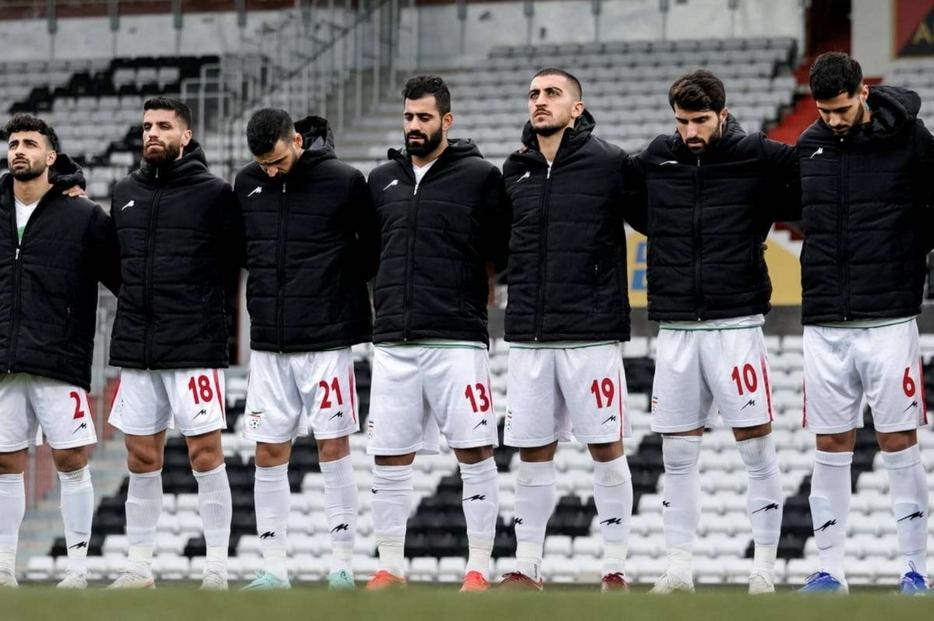
Iranian national team players wear black vests at the time of the national anthem in protest at the deaths of Mahsa Amini and Hadis Najafi76
The newly elected President Raisi signed an ordinance in August to enforce a new list of restrictions. This includes the introduction of surveillance cameras to monitor and fine women without headscarves77. According to the dress code, women in Iran must cover their hair and wear long, loose clothing. Torn jeans and brightly coloured dresses are also banned78. The rules are stricter for women working in state organisations or when appearing in public offices.
On state television, women wear two layers of scarves to ensure that no stray hairs are visible. To enter mosques, they must wear the chador, a large piece of cloth that leaves only the face or eyes visible, depending on how it is worn. Men are not immune from the dictates either, but to a much lesser extent. Long hair or hairstyles considered eccentric, as well as the wearing of shorts, jeans and T-shirts, are illegal, because they are thought to come from the West. These rules are enforced by the moral police in public areas. The police use white vans with green stripes and are mainly stationed in places frequented by young people79.
The torture vans are usually manned by a mixed male and female crew to ensure reserved dress and behaviour in public. After passing through a police station, the women detainees are taken to a ‘correction facility or re-education centre’, where they are taught to dress ‘properly’. They are generally released the same day, after a relative brings them ‘proper’ clothes80.
The morality police came into being and took the Persian name Gasht-e Ershad, which means Islamic-led patrol81, under the ultra-conservative former president Mahmoud Ahmadinejad82 , a fierce opponent of the West and proponent, among other things, of investments in the nuclear programme83. After Ahmadinejad came to power in 2005, the morality police were revamped and increased their presence in large cities84. An atrocious mockery, because Iran’s history, even during the monarchy, is quite different:85 before the Islamic revolution of 197986, women in the country enjoyed similar rights to men87.
When Ayatollah Ruhollah Khomeini came to power, the morality police took control of people’s lives, especially women’s lives88. A process of forced Islamisation, a crackdown on individual freedoms and customs, especially those of women, that is there for all to see. A social schizophrenia that causes clandestine suffering of millions of people, young people in particular, who study and travel the world, and are forced into the grip of archaic constraints89.
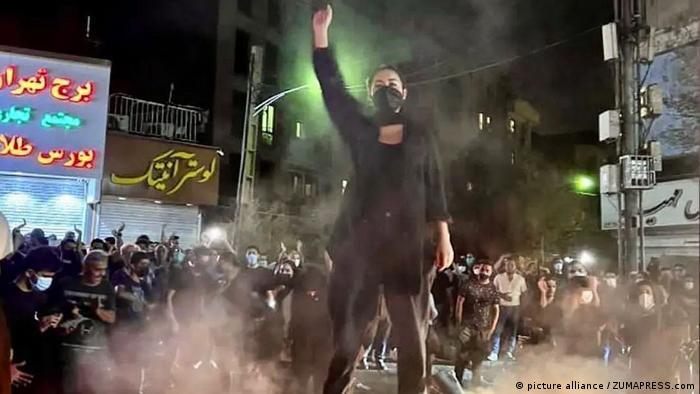
An image of the protests in Tehran90
Constrictions that violate human rights, freedom of expression, the rights of women, lgbtqi+ people, ethnic and religious minorities91. All because power seeks scapegoats for its own inability to lead the nation. It is no coincidence that precisely at a time when the economic crisis is being felt most, the bloody deaths of Mahsa, of Najafi, of Nika, of those protesting, have lit the fuse of a powder keg that has been in danger of exploding for 43 years. Iranians are not asking for revenge, they are demanding the right to live in freedom, in a secular regime where politics and religion are clearly separated.
It is hard to believe that they will get it. We live in a time in which the ruling cadres of politics and economics are totally inadequate, and cannot solve (or even consciously address) the enormous problems we face: the climate emergency; the destruction of the middle classes, which, in turn, brings with it an almost irreversible crisis of capitalism; the frightening degeneration of the systems of education and access to culture, which brings with it a total lack of awareness of one’s co-responsibility in the defence and exercise of democracy; the fact that the only growth sectors are the military, which, in order to continue growing, need war, death and destruction.
For decades, the identification of the enemy, guilty of everything, has been simple. In the days of national socialism, it was the Jews, then, depending on which side of the world you were on, the counter-revolutionaries and defeatists, or the communists. When that no longer worked either, the new enemy was identified in foreigners – especially those of a different ethnicity and religion. This is no longer enough. Now is the time when women will be blamed. To Eve, who ate the apple that cost us Paradise. After that, it will take very little to extinguish life on the planet, and wipe out the human race, which has done so much to destroy itself.
1 Otto, Jan Michiel, “Sharia Incorporated: A Comparative Overview of the Legal Systems of Twelve Muslim Countries in Past and Present”, Leiden University Press 2010
4 https://www.corriere.it/esteri/22_settembre_25/iran-hadis-najafi-20-anni-uccisa-sei-proiettili-mentre-manifestava-mahsa-amini-5cd33432-3cc5-11ed-823a-d6cc1a3a6eda.shtml
5 https://www.firstpost.com/explainers/explained-gasht-e-ershad-irans-controversial-morality-police-accused-of-mahsa-aminis-death-11304741.html
6 https://www.theguardian.com/world/2022/sep/23/iran-reportedly-arrests-journalist-activist-mahsa-amini-protests
7 https://www.firstpost.com/explainers/explained-gasht-e-ershad-irans-controversial-morality-police-accused-of-mahsa-aminis-death-11304741.html
8 https://www.theguardian.com/world/2022/sep/23/iran-reportedly-arrests-journalist-activist-mahsa-amini-protests
10 https://www.aljazeera.com/news/2022/9/23/iran-morality-police-root-cause-iranian-protest-anger-explainer
12 https://www.rainews.it/articoli/2022/09/iran-il-cugino-di-mahsa-amini-torturata-e-insultata-78d17ca5-4a84-421b-a2f1-81b7ec90dc8c.html
14 https://www.rainews.it/articoli/2022/09/iran-il-cugino-di-mahsa-amini-torturata-e-insultata-78d17ca5-4a84-421b-a2f1-81b7ec90dc8c.html
16 https://iranwire.com/en/women/107592-the-story-so-far-what-happened-to-mahsa-amini-at-the-detention-center/
18 https://www.theguardian.com/world/2022/sep/23/iran-reportedly-arrests-journalist-activist-mahsa-amini-protests
19https://www.nbcnews.com/news/world/cnns-christiane-amanpour-says-pulled-interview-irans-president-demand-rcna48922
20 https://iranwire.com/en/women/107592-the-story-so-far-what-happened-to-mahsa-amini-at-the-detention-center/
21 https://www.aljazeera.com/news/2022/9/25/iran-vows-decisive-action-as-mahsa-amini-protests-continue
22 https://www.cbsnews.com/amp/news/mahsa-amini-iran-protests-family-cousin-erfan-mortezaei-speaks-out-torture/#app
24 https://www.rainews.it/articoli/2022/09/iran-il-cugino-di-mahsa-amini-torturata-e-insultata-78d17ca5-4a84-421b-a2f1-81b7ec90dc8c.html
26 https://www.vanityfair.it/article/iran-bita-malakutitagliare-i-capelli-e-un-gesto-di-lutto-e-di-rabbia
27 https://www.theguardian.com/world/2022/sep/23/iran-reportedly-arrests-journalist-activist-mahsa-amini-protests
28 https://www.corriere.it/esteri/22_settembre_25/iran-hadis-najafi-20-anni-uccisa-sei-proiettili-mentre-manifestava-mahsa-amini-5cd33432-3cc5-11ed-823a-d6cc1a3a6eda.shtml
29 https://www.vanityfair.it/article/iran-bita-malakutitagliare-i-capelli-e-un-gesto-di-lutto-e-di-rabbia
30 https://www.theguardian.com/world/2022/sep/23/iran-reportedly-arrests-journalist-activist-mahsa-amini-protests
31 https://iran-hrm.com/2022/09/23/irans-chief-justice-calls-for-immediate-and-deterrent-action-against-protesters/
33 https://iran-hrm.com/2022/09/23/irans-chief-justice-calls-for-immediate-and-deterrent-action-against-protesters/
38 https://www.theguardian.com/world/2022/sep/23/iran-reportedly-arrests-journalist-activist-mahsa-amini-protests
39 https://www.reuters.com/world/middle-east/iranian-protesters-set-fire-police-station-unrest-over-womans-death-spreads-2022-09-22/
41 https://www.aljazeera.com/news/2022/9/23/iran-morality-police-root-cause-iranian-protest-anger-explainer
45 https://www.firstpost.com/explainers/explained-gasht-e-ershad-irans-controversial-morality-police-accused-of-mahsa-aminis-death-11304741.html
48 https://www.reuters.com/world/middle-east/iranian-protesters-set-fire-police-station-unrest-over-womans-death-spreads-2022-09-22/
49 https://www.lastampa.it/esteri/2022/09/27/news/morte_di_mahsa_amini_arrestata_lafiglia_dellex_presidente_peraverincitato_le_proteste_il_sostegno_di_jacobs_al_fianc-9828638/
50 https://www.theguardian.com/world/2022/sep/23/iran-reportedly-arrests-journalist-activist-mahsa-amini-protests
51 https://www.ansa.it/sito/notizie/cronaca/2022/10/01/iran-onda-di-protesta-in-italia-da-milano-a-napoli-dopo-la-morte-di-masha-amini_eae29077-f3ea-4f9c-9ed0-be31a0359647.html
53 https://www.lastampa.it/esteri/2022/09/27/news/morte_di_mahsa_amini_arrestata_lafiglia_dellex_presidente_peraverincitato_le_proteste_il_sostegno_di_jacobs_al_fianc-9828638/
55 https://www.dailymail.co.uk/news/article-11227441/What-true-bravery-looks-like-JK-Rowling-praises-Iranian-women.html
58 https://www.lastampa.it/esteri/2022/09/27/news/liran_dopo_mahsa_amini_ecco_chi_sonoi_venti_giornalisti_arrestati_che_fanno_tremare_il_regime-9771092/
59 https://unric.org/it/iran-diritti-umani-onu-condanna-la-violenta-repressione-della-protesta-degli-hijab/
64 https://www.lastampa.it/esteri/2022/09/27/news/morte_di_mahsa_amini_arrestata_lafiglia_dellex_presidente_peraverincitato_le_proteste_il_sostegno_di_jacobs_al_fianc-9828638/
66 https://www.repubblica.it/esteri/2022/09/30/news/liran_arrestati_i_cittadini_di_nove_paesi_stranieri_ci_sarebbero_anche_italiani-368048766/
69 https://www.ansa.it/sito/notizie/mondo/2022/10/01/iran-terroristi-fomentano-le-proteste-oltre-200-arrestati_96290107-5fac-4636-9c08-84998d6efbd0.html
70 https://unric.org/it/iran-diritti-umani-onu-condanna-la-violenta-repressione-della-protesta-degli-hijab/
71 https://www.repubblica.it/esteri/2022/09/30/news/liran_arrestati_i_cittadini_di_nove_paesi_stranieri_ci_sarebbero_anche_italiani-368048766/
75 https://www.reuters.com/world/middle-east/iranian-protesters-set-fire-police-station-unrest-over-womans-death-spreads-2022-09-22/
78 https://www.firstpost.com/explainers/explained-gasht-e-ershad-irans-controversial-morality-police-accused-of-mahsa-aminis-death-11304741.html
79 https://www.aljazeera.com/news/2022/9/23/iran-morality-police-root-cause-iranian-protest-anger-explainer
80 https://www.firstpost.com/explainers/explained-gasht-e-ershad-irans-controversial-morality-police-accused-of-mahsa-aminis-death-11304741.html
81 https://www.aljazeera.com/news/2022/9/23/iran-morality-police-root-cause-iranian-protest-anger-explainer
82 https://www.firstpost.com/explainers/explained-gasht-e-ershad-irans-controversial-morality-police-accused-of-mahsa-aminis-death-11304741.html
84 https://www.firstpost.com/explainers/explained-gasht-e-ershad-irans-controversial-morality-police-accused-of-mahsa-aminis-death-11304741.html
85 https://www.firstpost.com/world/explained-hijab-travel-restrictions-and-more-how-iranian-womens-freedom-has-been-snatched-since-1979-islamic-revolution-11294251.html
87 https://www.aljazeera.com/news/2022/9/23/iran-morality-police-root-cause-iranian-protest-anger-explainer
88 https://www.firstpost.com/explainers/explained-gasht-e-ershad-irans-controversial-morality-police-accused-of-mahsa-aminis-death-11304741.html
Leave a Reply